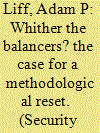| Srl | Item |
| 1 |
ID:
165095


|
|
|
|
|
| Summary/Abstract |
What factors do autocracies evaluate when responding to perceived threats and why might they fail to balance appropriately? I posit that autocratic leaders may choose greater exposure to an external threat if, by doing so, it preserves regime legitimacy. Specifically, the desire to promote a positive image to one’s domestic public creates incentives to publicly downplay a rival’s military progress, which then affects the state’s ability to mobilize resources to respond to the growing threat. I test this theory in the case of China’s response to India’s military rise. This research contributes to balancing theory and empirical work on East Asian security.
|
|
|
|
|
|
|
|
|
|
|
|
|
|
|
|
| 2 |
ID:
147908


|
|
|
|
|
| Summary/Abstract |
Post-Cold War, balancing theory has fallen on “hard times.” A question of crucial importance for 21st-century peace and stability concerns how Asia–Pacific secondary states are responding militarily to China's rise. China's rapid growth, military modernization, and controversial policies vis-à-vis contested space and territories on its periphery make it a prime candidate for counterbalancing behavior. Yet several recent studies claim that secondary states are accommodating, even bandwagoning with, Beijing. This study challenges these claims, attributing them largely to problematic research designs not uncommon in the wider balancing literature. It proposes a methodological corrective, arguing for widespread employment of an alternative analytical framework relying on clearer definitions and explicitly delineated sets of 21st-century-relevant metrics reflecting the myriad ways contemporary militaries enhance their capabilities in response to perceived threats. Applied systematically to original analysis of the contemporary Asia–Pacific, this framework uncovers what existing studies miss—evidence of practically significant and accelerating balancing against China.
|
|
|
|
|
|
|
|
|
|
|
|
|
|
|
|